October 2023 Regulatory Update
Legislation has been passed by the European Union with the aim of regulating microplastics, and it falls under a new entry to Annex XVII of REACH Regulation (EC) 1907/2006. The new law, Commission Regulation (EU) 2023/2055, will be introduced in several stages, with the first phase commencing on 17 October 2023.
View Story Read MoreOn 27 September 2023, the European Union (EU) introduced Commission Regulation (EU) 2023/2055, which amends Annex XVII to Regulation (EC) No 1907/2006 of the European Parliament and of the Council concerning the Registration, Evaluation, Authorisation and Restriction of Chemicals (REACH), by creating a new entry 78 to Annex XVII. This new entry is specific to the restriction on synthetic polymer microparticles (“Microplastics”) as substances on their own and in mixtures. This regulation will enter into force on 17 October 2023.
According to this amendment, synthetic polymer microparticles (“microplastics”) are defined as “polymers that are solid”, and which fulfil both of the following conditions:
- are contained in particles and constitute at least 1 % by weight of those particles; or build a continuous surface coating on particles.
- at least 1 % by weight of the particles referred to in point (a) fulfil either of the following conditions:
- - All dimensions of the particles are equal to or less than 5 mm.
- - The length of the particles is equal to or less than 15 mm and their length to diameter ratio is greater than 3.
On top of the definition for microplastics as shown, the following polymers are excluded from this designation:
- Polymers that are the result of a polymerization process that has taken place in nature, independently of the process through which they have been extracted, which are not chemically modified substances.
- Polymers that are degradable as proved in accordance with Appendix 15 “Rules on proving degradability” in this regulation.
- Polymers that have a solubility greater than 2 g/L as proved in accordance with Appendix 16 “Rules on proving solubility” in this regulation.
- Polymers that do not contain carbon atoms in their chemical structure.
In addition, this regulation also introduces some important provisions such as,
- Except for scenario 2 - 11 in the summary table below, synthetic polymers microparticles, on their own or in mixtures, which have been placed on the market before 17 October 2023, may continue to be placed on the market, to prevent unnecessary product recalls and reduce waste.
- Exemptions for the usage of synthetic polymer microparticles are listed below.
- - When used as substances on their own or in mixtures, for use at industrial sites.
- - When contained by technical means so that releases to the environment are prevented when used in accordance with the instructions for use during the intended end use.
- - When permanently incorporated into a solid matrix during intended end use.
- - When synthetic polymer microparticles are used in product categories such as medicinal products, veterinary medicinal products, in vitro diagnostic devices and food additives.
- From 17 October 2025, suppliers of microplastics meant for use at industrial sites, will have to furnish specific details.
- From 17 October 2025, suppliers of the below products containing microplastics shall provide instructions to professional users and the general public for use and disposal on how to prevent the release of microplastics to the environment.
- - Microplastics which are permanently incorporated into a solid matrix during intended end use.
- - Microplastics which are contained by technical means and are not being released into the environment during intended use.
- From 17 October 2026, suppliers of in vitro diagnostic devices shall be subject to the same measures as stated in (d) as above.
- From 17 October 2031 to 16 October 2035, suppliers of lip, nail and make-up products containing microplastics shall provide the statement on the article indicating, “This product contains microplastics”. (However, products placed on the market before 17 October 2031 are not required to bear that statement until 17 December 2031.)
- From 31 May 2026, manufacturers and industrial downstream users of synthetic polymer microparticles in the form of pellets, flakes, and powders used as feedstock in plastic manufacturing at industrial sites shall submit the information to the European Chemicals Agency (ECHA) by 31 May of each year.
- From 31 May 2027, other manufacturers of synthetic polymer microparticles and other industrial downstream users utilizing synthetic polymer microparticles at industrial sites shall follow the same measures as stated in (g) as above.
- By 31 May 2027 (and each year thereafter), suppliers are required to submit information to ECHA if they place, among other things, microplastics that are permanently incorporated into a solid matrix during intended end use on the market for the first time for professional users and the general public.
- If requested by EU authorities, manufacturers, importers and industrial downstream users of products containing microplastics shall provide specific information on the identity and function of those polymers in their products.
- Manufacturers, importers and industrial downstream users of products containing polymers that are exempt from the designation of microplastics, shall prove that the product is degradable with reference to Appendix 15 (or soluble in accordance with Appendix 16) of this regulation.
To further clarify on the interpretation of this regulation, the European Commission elaborated on the microplastic restriction (EU) 2023/2055 in their website Commission Regulation (EU) 2023/2055 - Restriction of microplastics intentionally added to products (europa.eu), with several key points as summarized below.
- The regulation restricts certain types and uses of glitter depending on what the glitter is made of, what it is used for and whether it is loose, trapped in or attached to an object.
- Loose plastic glitter for uses as arts and crafts, toys is banned as of 17 October 2023 (unless biodegradable or soluble). For plastic glitter that is affixed to objects, the ban would apply as of 17 October 2023 only to glittered decorative objects from which glitter detaches during normal use.
- Plastic glitter that is trapped in a solid matrix when used (e.g., glitter glue), solid film (e.g., paints, inks) or solid objects (inside jewelry) or is fully contained (e.g., in snow globes) is not affected by the ban.
- Glittered articles for which the decorative function is secondary such as garments, footwear, curtains, etc. are out of the scope of the restriction.
- For glittered articles which have a purely decorative function such as Christmas decorations, toy/party hats, etc.,
- If the glitter does not detach from the article during normal end use, glitter is regarded as an integral part of the article and it is out of the scope of the restriction.
- If the glitter detaches from the article during normal end use, the restriction applies.
The below table provides a summary of the amendment of REACH Annex XVII regarding EU microplastic regulation in significant aspects.

Note:
* When the concentration of synthetic polymer microparticles cannot be determined by available analytical methods or accompanying documentation, in order to verify the compliance with the concentration limit, only the particles of at least the following size shall be considered:
- 0.1 μm for any dimension, for particles where all dimensions are ≤ 5 mm.
- 0.3 μm in length, for particles that have a length ≤ 15 mm and a length to diameter ratio > 3.
On 23 August 2023, a European Standard for Candle Accessories EN 17885-2023 was published.
The aim of the standard is to outline the necessary safety measures and evaluation procedures for candle accessories, along with instructions for displaying safety information. The requirements and test methods presented are designed to address the most prevalent fire hazards in common usage.
View Story Read MoreOn 23 August 2023, a European Standard for Candle Accessories EN 17885-2023 was published.
A candle accessory is defined as, “object intended or marketed for use with candle”. Per the standard, it is noted that the container of a “container candle” (e.g., tea light candle) is not regarded as a candle accessory.
The objective of the standard is to outline the necessary safety measures and evaluation procedures for candle accessories, along with instructions for displaying safety information. The requirements and test methods presented are designed to address the most prevalent fire hazards in common usage.
The standard stipulates safety criteria covering several areas, including Flammability, Stability, Fire Safety, and Surface Temperature Limitations for accessible parts, as well as product safety label requirements.
In Europe, when hazards are identified in non-food consumer products, the products will be recalled and published in the Safety Gate system, which is updated weekly. The European recalls from 01 September 2023 to 30 September 2023 are summarized below:
View Story Read More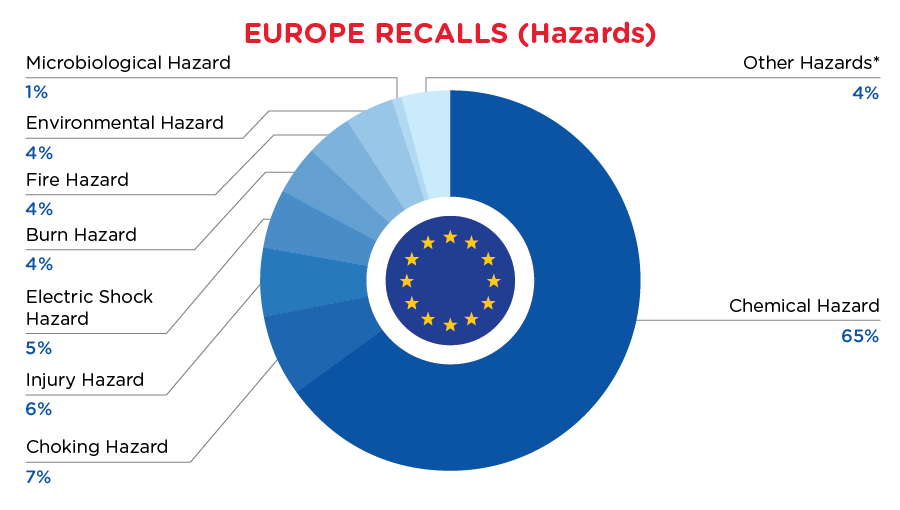
| Hazards | Frequency |
| Chemical Hazard | 194 |
| Choking Hazard | 22 |
| Injury Hazard | 18 |
| Electric Shock Hazard | 16 |
| Burn Hazard | 13 |
| Fire Hazard | 13 |
| Environmental Hazard | 10 |
| Microbiological Hazard | 4 |
| Other Hazards* | 10 |
*Other Hazards include Entrapment Hazard, Drowning Hazard, Cut Hazard and Strangulation Hazard with a frequency of less than 4.
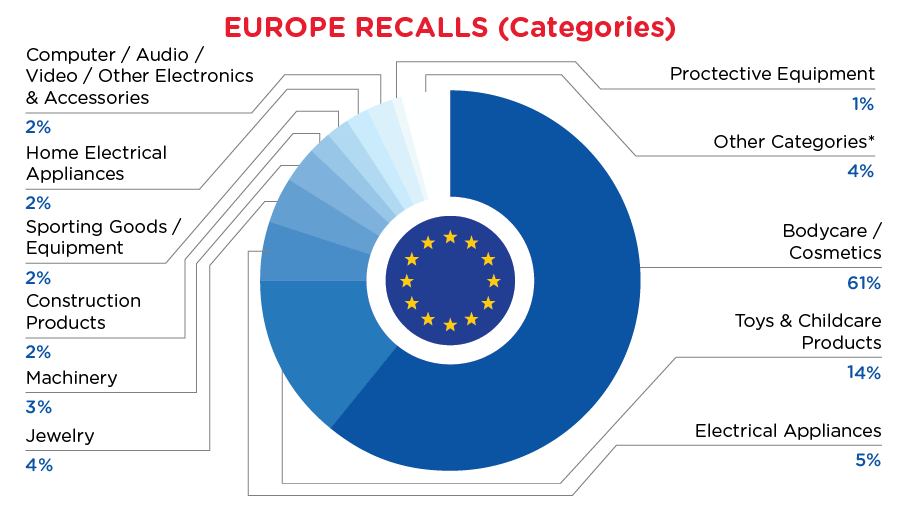
| Product Categories | Frequency |
| Bodycare / Cosmetics | 170 |
| Toys and Childcare Products | 39 |
| Electrical Appliances | 14 |
| Jewelry | 10 |
| Machinery | 7 |
| Computer / Audio / Video / Other Electronics & Accessories | 5 |
| Construction Products | 5 |
| Sporting Goods / Equipment | 5 |
| Home Electrical Appliances | 5 |
| Protective Equipment | 4 |
| Other Categories* | 12 |
*Other Categories include Chemicals, Fabric / Textile / Garment / Home Textile, Car Components, Household Items, Tools and Hardware and Accessories with a frequency of less than 4.
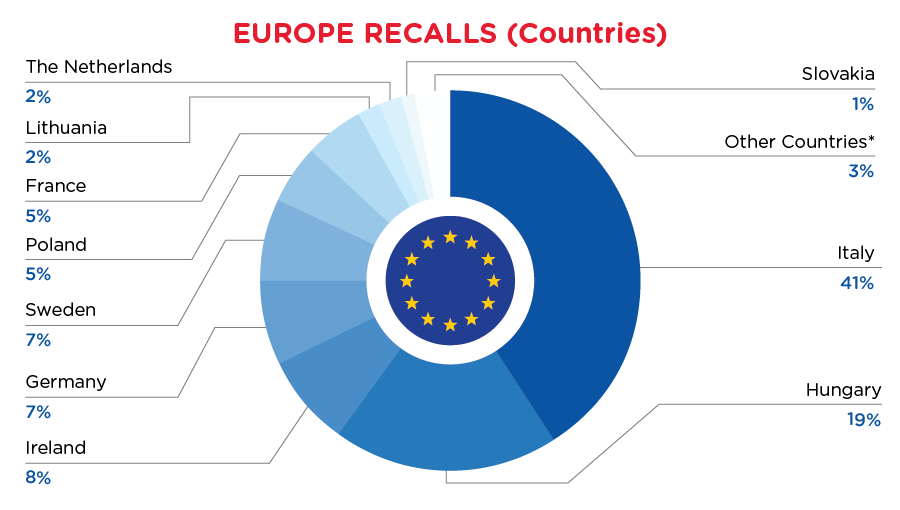
| Notifying Country | Frequency |
| Italy | 114 |
| Hungary | 53 |
| Ireland | 21 |
| Germany | 20 |
| Sweden | 18 |
| Poland | 15 |
| France | 13 |
| Lithuania | 5 |
| The Netherlands | 5 |
| Slovakia | 4 |
| Other Countries* | 8 |
*Other Countries include Czechia, Finland, Belgium, Denmark and Norway with a frequency of less than 4.
For a complete list click here
On 5 September 2023, the Australian mandatory standard for toys for children up to and including 36 months of age was updated.
The primary aim of the mandatory standard is to minimize the likelihood of small parts detaching or becoming dislodged from toys during usage or expected wear and tear, ultimately mitigating the risk of choking, suffocation, or fatality. Additionally, the standard outlines particular provisions pertaining to toys that incorporate batteries.
Suppliers have until 4 March 2025 to transition to the requirements of the newly updated mandatory standard.
View Story Read MoreOn 5 September 2023, the Australian mandatory standard for toys for children up to and including 36 months of age was updated.
Per the standard, to conform, toys for children up to and including 36 months of age shall comply with certain sections of one of the following standards:
- Australian standard AS/NZS ISO 8124.1:2023 Safety of toys – Part 1: Safety aspects related to mechanical and physical properties
- International (ISO) standard ISO 8124‑1:2022 Safety of toys – Part 1: Safety aspects related to mechanical and physical properties
- European (EN) standard EN 71‑1:2014 + A1:2018: Safety of toys – Part 1: Mechanical and physical properties
- American (ASTM) standard ASTM F963‑17 Standard Consumer Safety Specification for Toy Safety.
The standard also requires toys for children up to and including 36 months of age that include a battery to have its battery compartment secured in such a way that it can only be accessed by using a tool. This requirement aims to prevent potential harm caused by easily accessible batteries, as young children may inadvertently swallow these as small parts.
Suppliers have until 4 March 2025 to transition to the requirements of the new mandatory standard. During this transition period, suppliers may either comply with the amended Consumer Protection Notice No. 14 of 2003 (amended by Consumer Protection No.1 of 2005) or the new Consumer Goods (Toys for Children up to and including 36 Months of Age) Safety Standard 2023. However, beginning on 5 March 2025, suppliers must strictly adhere to the new Consumer Goods (Toys for Children up to and including 36 Months of Age) Safety Standard 2023.
Consumer Goods (Care Labelling) Information Standard 2023 was updated on 5 September 2023 and specifies the labelling requirements for clothing and textile products.
View Story Read MoreThe updated Consumer Goods (Care Labelling) Information Standard 2023, sets out the mandatory requirements for the labelling of a variety of prescribed products.
This mandatory standard is based on certain sections of the voluntary Australian/New Zealand Standard AS/NZS 1957:1998 Textiles - Care labelling and the International Standard ISO 3758:2012 Textiles—Care labelling code using symbols.
On condition that the requirements of the mandatory standard are met, suppliers may provide extra information, such as care instructions in other languages.
The mandatory standard for care labelling for clothing and textiles applies to:
- Clothing
- Household textiles
- Furnishings
- Piece goods made from textiles
- Plastic coated fabrics
- Suede skins
- Leathers
- Furs
Key requirements:
These requirements are intended to give suppliers a general idea of what is required by the mandatory standard. Suppliers must not rely on this information as a complete guide to compliance.
The mandatory standard provides transition periods to assist suppliers to adjust to the new requirements.
Transitional period:
From 5 September 2023 until 4 March 2024 suppliers must continue to provide a care label (instructions) written in English but can additionally provide care symbols if they wish.
From 5 March 2024, suppliers can choose to provide care instructions by using a care label written in English or by using the care symbols, or both.
In Australia, when hazards are identified in consumer products, they will be recalled and published in the Recalls and Safety Alerts Database on the Australian Competition & Consumer Commission website, which is updated daily. The Australia recalls from 01 September 2023 to 30 September 2023 are summarized below:
View Story Read More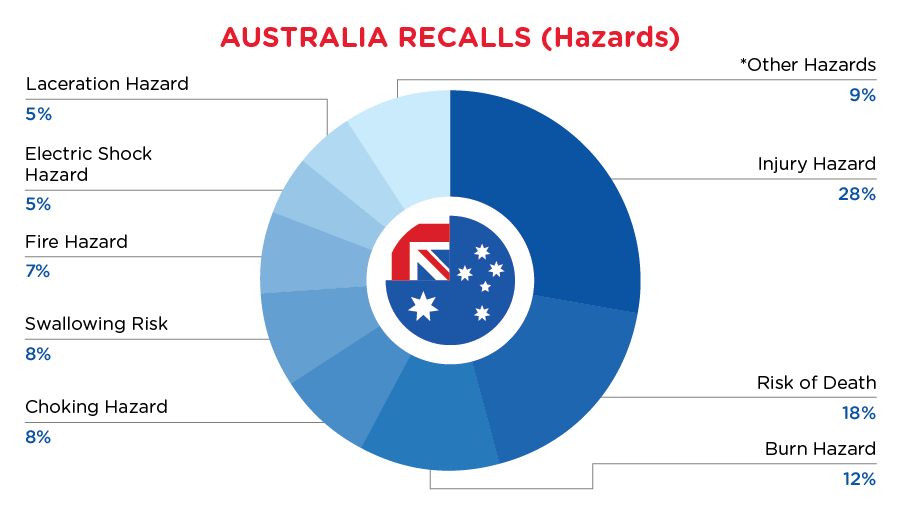
| Hazards | Frequency |
| Injury Hazard | 21 |
| Risk of Death | 13 |
| Burn Hazard | 9 |
| Choking Hazard | 6 |
| Swallowing Risk | 6 |
| Fire Hazard | 5 |
| Electric Shock Hazard | 4 |
| Laceration Hazard | 4 |
| *Other Hazards | 7 |
*Other Hazards include Fall Hazard, Crash Hazard, Risk of Exposure to Combustion Flue Gas and Explosion Hazard with a frequency of less than 4.
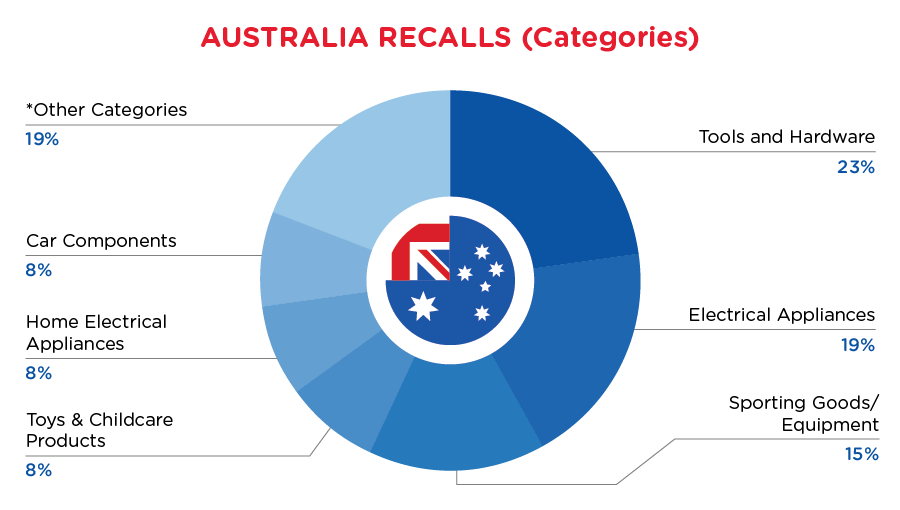
| Product Categories | Frequency |
| Tools and Hardware | 6 |
| Electrical Appliances | 5 |
| Sporting Goods / Equipment | 4 |
| Toys and Childcare Products | 2 |
| Home Electrical Appliances | 2 |
| Car Components | 2 |
| Other Categories* | 5 |
*Other Categories include Household Items, Food Contact Material, Fabric / Textile / Garment / Home Textile, Footwear and Furniture with a frequency of less than 2.
For a complete list click here
On 23 August 2023, the Standard Specification for Fire Safety for Candles ASTM F2417 was updated from the 2017 version to the 2023 version.
The purpose of this specification is to establish the essential safety standards for candles and candle ensembles, to promote a satisfactory level of safety during regular candle usage, consequently diminishing the likelihood of fire outbreaks, fatalities, and harm to individuals.
View Story Read MoreThe Standard Specification for Fire Safety for Candles ASTM F2417 was updated from the 2017 version to the 2023 version on 23 August 2023.
The purpose of this specification is to establish the essential safety standards for candles and candle ensembles, to promote a satisfactory level of safety during regular candle usage, thereby reducing the likelihood of fire outbreaks, fatalities, and harm to individuals.
The majority of the tests are unchanged from the 2017 edition of the standard, but inclusions for the below have been addressed:
- Added definition of a candle making kit
- Added wick migration and wick leaning safety requirements for all filled candles
In the US, when hazards are identified in consumer products, they will be recalled and published in the Consumer Product Safety Commission (CPSC) Recent Recalls on the CPSC website, which is updated daily. The US recalls from 01 September 2023 to 30 September 2023 are summarized below:
View Story Read More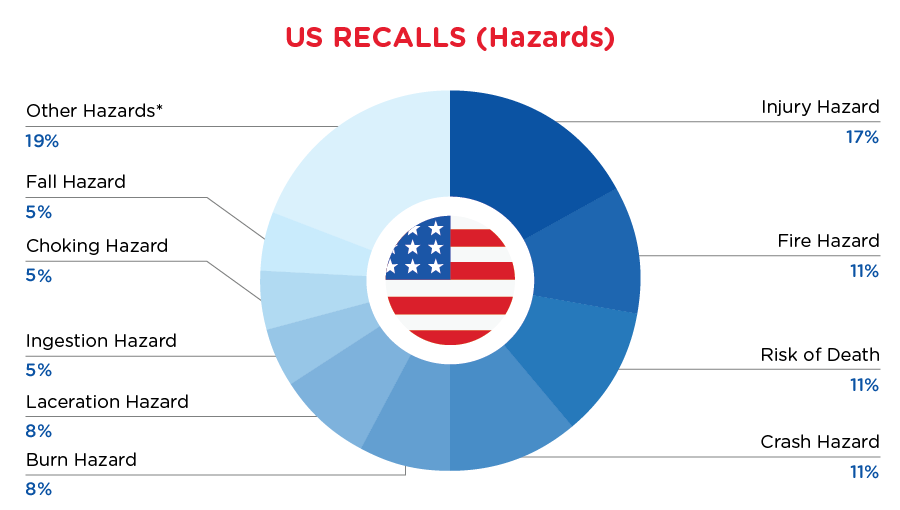
| Hazards | Frequency |
| Injury Hazard | 6 |
| Fire Hazard | 4 |
| Risk of Death | 4 |
| Crash Hazard | 4 |
| Burn Hazard | 3 |
| Laceration Hazard | 3 |
| Ingestion Hazard | 2 |
| Choking Hazard | 2 |
| Fall Hazard | 2 |
| Other Hazards* | 7 |
*Other Hazards include Risk of Exposure to Combustion Flue Gas, Risk of Allergy, Poisoning Hazard, Impact Hazard, Electric Shock Hazard, Health Risk Hazard, Lead Poisoning Hazard with a frequency of less than 3.
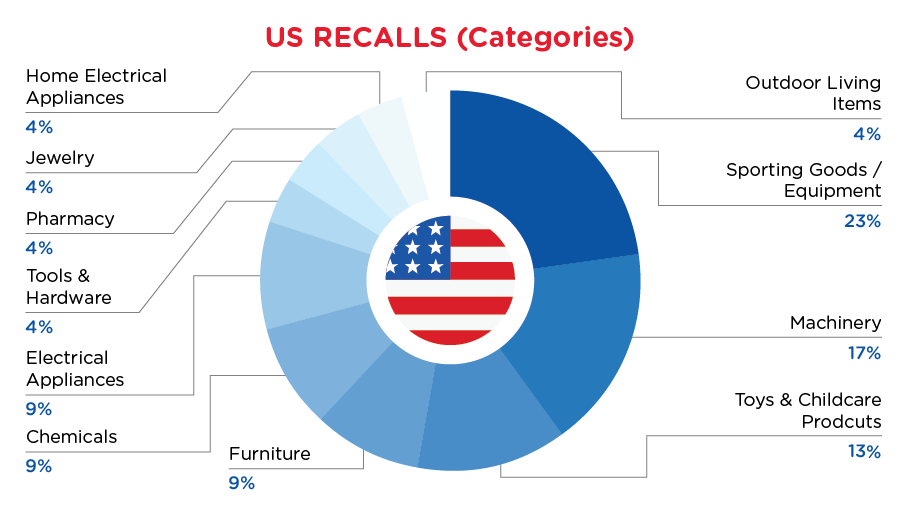
| Product Categories | Frequency |
| Sporting Goods / Equipment | 5 |
| Machinery | 4 |
| Toys and Childcare Products | 3 |
| Furniture | 2 |
| Chemicals | 2 |
| Electrical Appliances | 2 |
| Tools and Hardware | 1 |
| Pharmacy | 1 |
| Jewelry | 1 |
| Home Electrical Appliances | 1 |
| Outdoor Living Items | 1 |
For a complete list click here
In Canada, when hazards are identified in consumer products, they will be recalled and published in the Recalls and Safety Alerts Database on the Health Canada website, which is updated daily. The Canada recalls from 01 September 2023 to 30 September 2023 are summarized below:
View Story Read More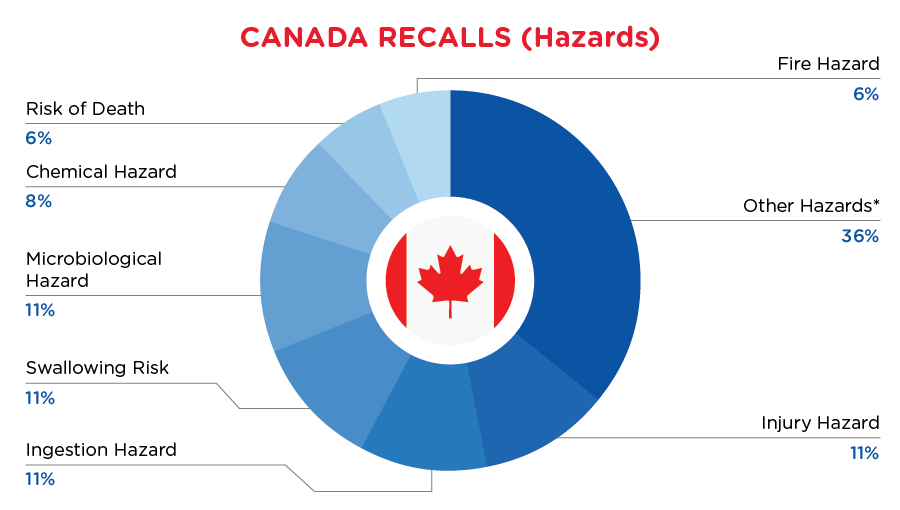
| Hazards | Frequency |
| Injury Hazard | 6 |
| Ingestion Hazard | 6 |
| Swallowing Risk | 6 |
| Microbiological Hazard | 6 |
| Chemical Hazard | 4 |
| Risk of Death | 3 |
| Fire Hazard | 3 |
| Other Hazards* | 19 |
*Other Hazards include Burn Hazard, Laceration Hazard, Fall Hazard, Health Risk Hazard
Lead Poisoning Hazard, Electric Shock Hazard, Safety Risk Hazard, Entrapment Hazard, Choking Hazard, Drowning Hazard, Crash Hazard, Suffocation Hazard, Entanglement Hazard, Strangulation Hazard with a frequency of less than 3.
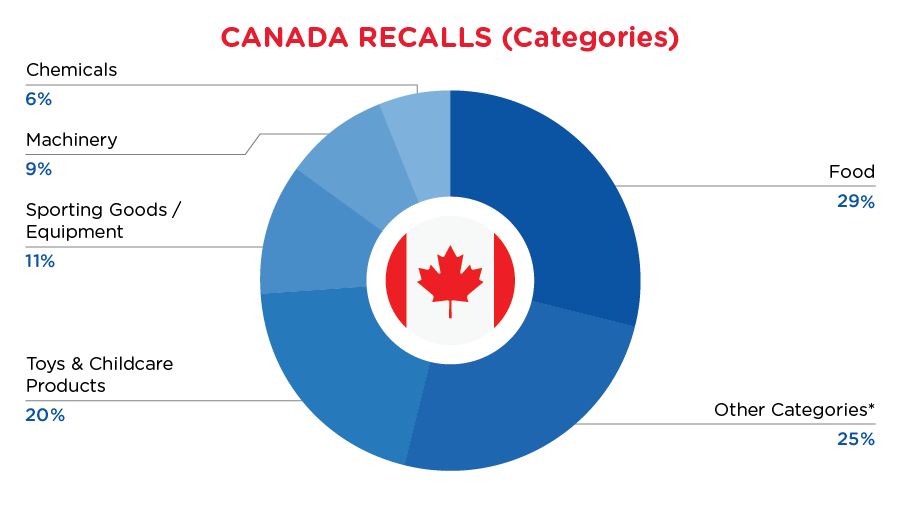
| Product Categories | Frequency |
| Food | 10 |
| Toys and Childcare Products | 7 |
| Sporting Goods / Equipment | 4 |
| Machinery | 3 |
| Chemicals | 2 |
| Other Categories* | 9 |
*Other Categories include Household Items, Tools and Hardware, Electrical Appliances, Fabric / Textile / Garment / Home Textile, Stationery, Outdoor Living Items, Food Contact Material, Furniture and Jewelry with a frequency of less than 2.
For a complete list click here
The National Health Commission of China published Notice No.5 of 2023 to approve several substances and materials for food contact use.
View Story Read MoreOn August 2023, The National Health Commission (NHC) of China published Notice No.5 of 2023 to announce new substances and materials safe for food contact use. The notification includes two food contact additives and one food contact resin material.
- New additives for food contact materials and articles

- New resins for food contact materials and articles.

This standard became effective upon publication in August 2023.
In China, when hazards are identified in consumer products, they will be recalled and published in the SAMR Defective Product Administrative Centre, which is updated daily. The China recalls from 01 September 2023 to 30 September 2023 are summarized below:
View Story Read More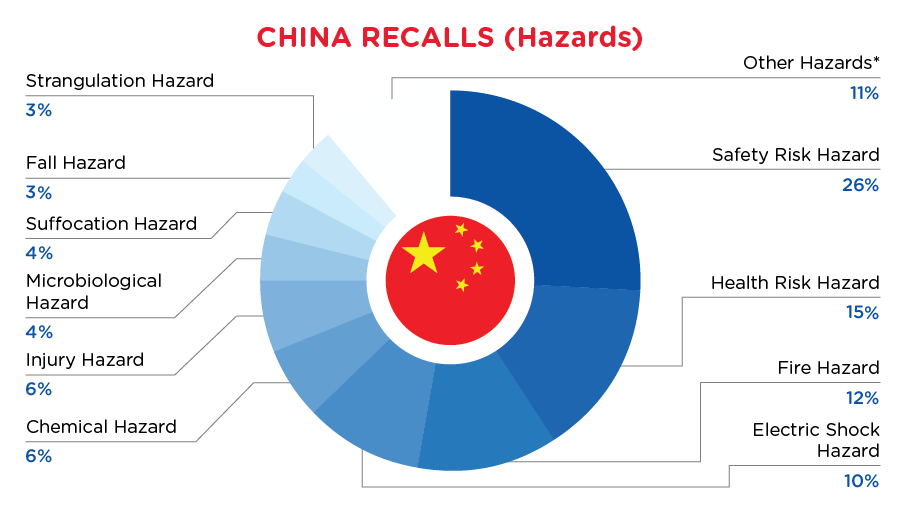
| Hazards | Frequency |
| Safety Risk Hazard | 47 |
| Health Risk Hazard | 27 |
| Fire Hazard | 22 |
| Electric Shock Hazard | 19 |
| Chemical Hazard | 12 |
| Injury Hazard | 11 |
| Microbiological Hazard | 7 |
| Suffocation Hazard | 7 |
| Fall Hazard | 6 |
| Strangulation Hazard | 5 |
| Other Hazards* | 21 |
*Other Hazards include Risk of Allergy, Crash Hazard, Burn Hazard, Laceration Hazard, Entanglement Hazard, Explosion Hazard, Risk of Death, Choking Hazard and Cut Hazard with a frequency of less than 5.
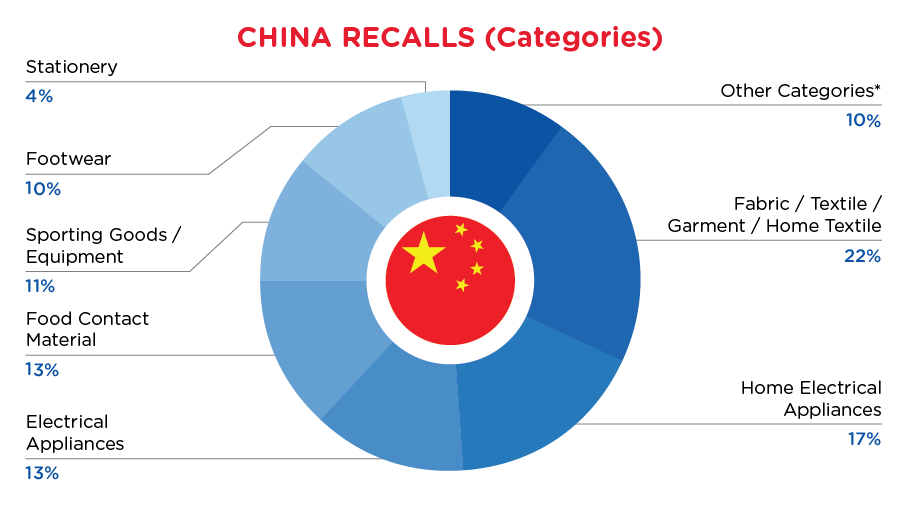
| Product Categories | Frequency |
| Fabric / Textile / Garment / Home Textile | 18 |
| Home Electrical Appliances | 15 |
| Electrical Appliances | 11 |
| Food Contact Material | 11 |
| Sporting Goods / Equipment | 9 |
| Footwear | 8 |
| Stationery | 3 |
| Other Categories* | 8 |
*Other product categories include Toys and Childcare Products, Chemicals, Furniture, Protective Equipment and Household Items with a frequency of less than 3.
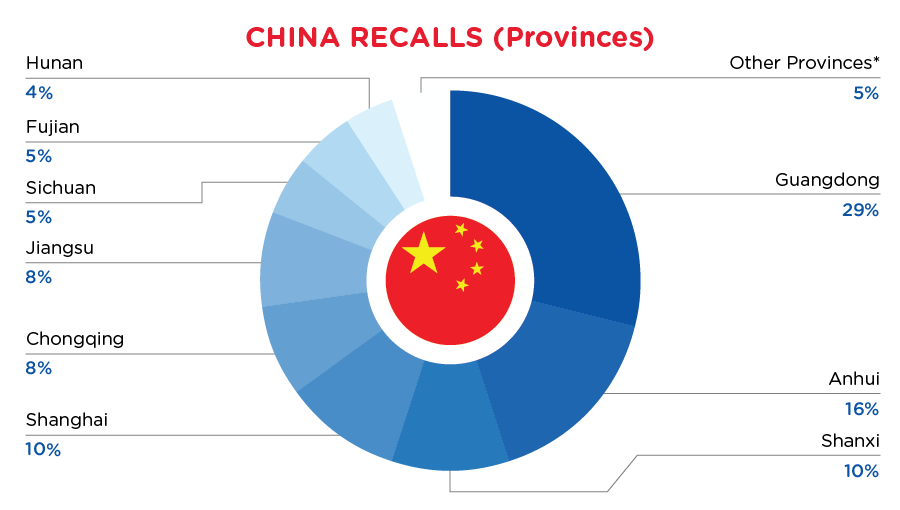
| Provinces | Frequency |
| Guangdong | 25 |
| Anhui | 13 |
| Shanxi | 8 |
| Shanghai | 8 |
| Chongqing | 7 |
| Jiangsu | 7 |
| Sichuan | 4 |
| Fujian | 4 |
| Hunan | 3 |
| Other Provinces* | 4 |
*Other Provinces include Tianjin, Beijing and Henan with a frequency of less than 3.
For a complete list click here

